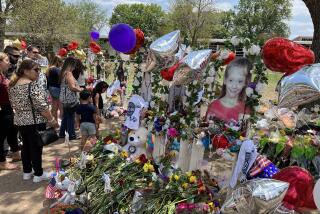Opinion: How not to report on mass shootings

Like most of the hellscapes we now wade through, endemic gun violence is a tragedy of our own making. The Parkland story is like other stories: a 19-year-old gunman entered his former high school, this time in South Florida, and killed 17 people. Fourteen of them were students.
But this time, journalists became part of the story of our eminently preventable national nightmare when reporters from CNN, the Miami Herald, ABC and a local news station publicly messaged a high school student, Aidan Minoff, who was tweeting during the shooting. They asked him to follow them back; to direct message them; for video permissions; even for a phone interview. Many read their requests as disgusting and desperate; of course, journalism is increasingly both. Decent jobs are hard to come by and harder to keep, clicks are king, and the 24-hour digital news cycle makes reporters run at a race clip.
The journalist’s job is not to make the aftermath of a tragedy more bearable. But our first obligation is to not make it worse.
Examples of “what not to do when reporting on tragedy” are legion; anyone who’s worked the crime beat will have stories to share. In 2015, I reported from a public vigil for a young man who died in a drive-by shooting. The vigil occurred less than 24 hours after he was killed. I watched as one reporter poked the dead man’s weeping friends during the ceremony. “I know just how you feel,” she announced. “Someone I knew died in 9-11.” The reporter was an older blond woman flown in from New York City, using a wildly different loss as a card to connect with Latino men in their mid-20s who lived in a California neighborhood where their friends were getting shot every other day. It reminded me of the famous scene in “Broadcast News” in which anchorman Tom Grunick, played by William Hurt, pretends to cry while talking to a rape survivor.
If it’s clear how to be a jerk while reporting from a mass casualty event, it is perhaps less clear how to report respectfully while still getting as much information as possible to the public. I called Andrew M. Seaman, the Society of Professional Journalists’ ethics committee chair, and Bruce Shapiro, executive director of the Dart Center for Journalism and Trauma at Columbia University, for their advice on how tragedies should be covered. Here’s a quick guide:
Reporters should make sure survivors are and feel safe. If someone is tweeting out information and images from an active scene, the first and only obligation is to their safety. A direct message on Twitter can make a person’s phone chime. Reporters need to be aware that a shooter might use the sound of ringing phone or a person’s voice to locate victims, as Anders Behring Brevik, the shooter in Utoya, Norway, did when he shot 69 people at a summer camp.
“The temptation to grab a little bit of live action,” Shaprio argues, “needs to be set against the absolute commitment to the safety of someone who is in fear for their life.”
Reporters should be empathetic. “Trauma is a profoundly isolating experience; it leaves people with an almost incommunicable sense of isolation,” says Shapiro. “One of our great capacities as reporters is to link survivors and the broader community again through the power of our stories. That’s actually a great privilege and it’s something that only journalism can do. The other side is that it’s also very easy to be exploitative or obtrusive.”
Reporters should do their research. “Reporters should be very cautious about putting out assertions coming only from a single text exchange or tweet. It’s factually dangerous to put out inaccurate information in the middle of an active shooting scene and it lays down wrong myths that are very hard to break. You don’t want to be taken for a ride by someone who’s not really there,” Shapiro says. If reporters are on the scene or in the immediate aftermath, their job is to provide the world with the most accurate version of events possible, not to get the most sensational footage or quotes. He points to Dave Cullen’s book “Columbine,” which highlights inaccurate early reporting on that tragedy, for instance, that the perpetrators were part of a “trench coat mafia.” More information is available on the DART Center website.
Reporters should publicly acknowledge what they don’t know. “The most important thing journalists should do during these events is take a breath,” Seaman says. “Nobody ever got fired for pausing to ask whether they’re making the right decision.” He suggests putting an editor’s note on the story saying: “This story is unfolding. We’re doing the best we can in terms of identifying what is and is not appropriate to share.”
Reporters should speak to a range of survivors. “One of the things that happens a lot is that there turn out to be a few people who for whatever reason turn out to be good on TV; they’re comfortable talking to press and have a clear set of views,” Shapiro says. “When you find a good source, everyone moves toward them. That’s a danger to be aware of. You can end up overexposing someone who may not be helped by constantly repeating their experience and you have some survivors who feel left out of media attention because we haven’t made an affirmative effort.”
Covering tragedies can be difficult, uncomfortable and full of moral quandaries for even the most ethical journalists. Unlike social workers, EMTs, and other helpers on the scene, the journalist’s job is not to make the aftermath of a tragedy more bearable. But our first obligation is to not make it worse.
Melissa Batchelor Warnke is a contributing writer to Opinion. Follow her on Twitter: @velvetmelvis.
Follow the Opinion section on Twitter @latimesopinion and Facebook.
More to Read
A cure for the common opinion
Get thought-provoking perspectives with our weekly newsletter.
You may occasionally receive promotional content from the Los Angeles Times.











